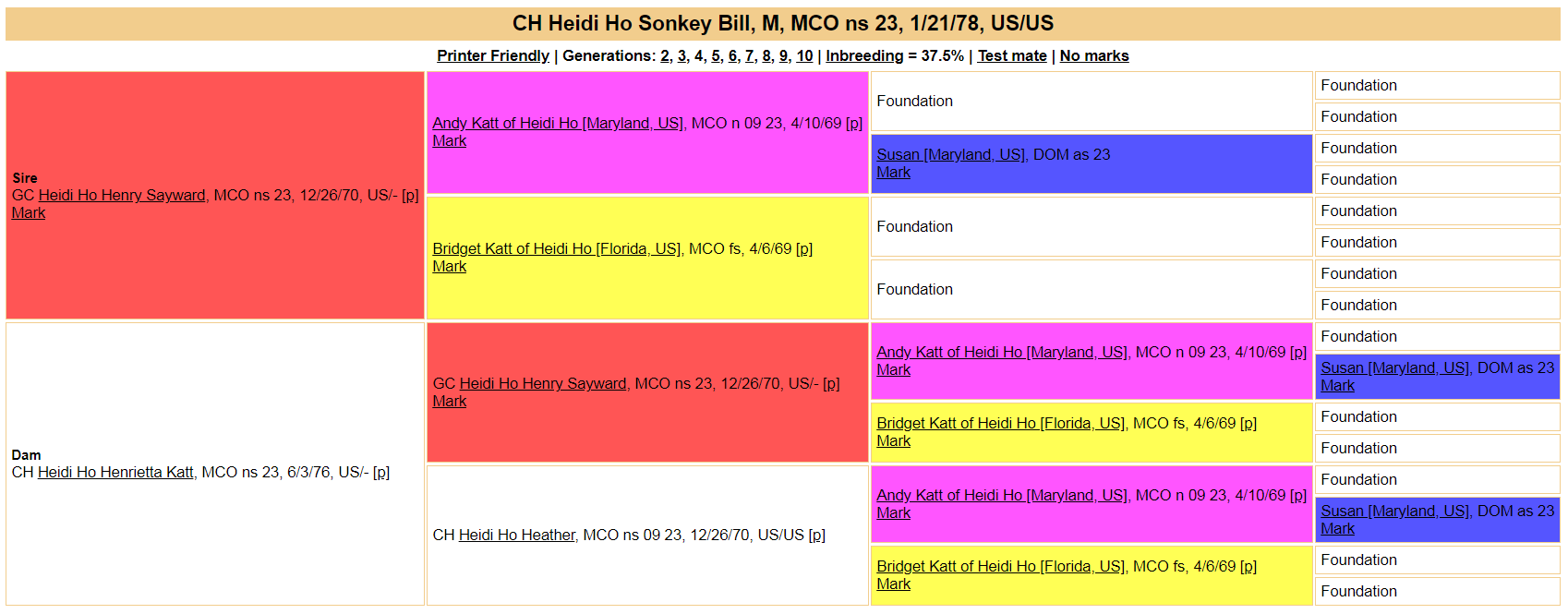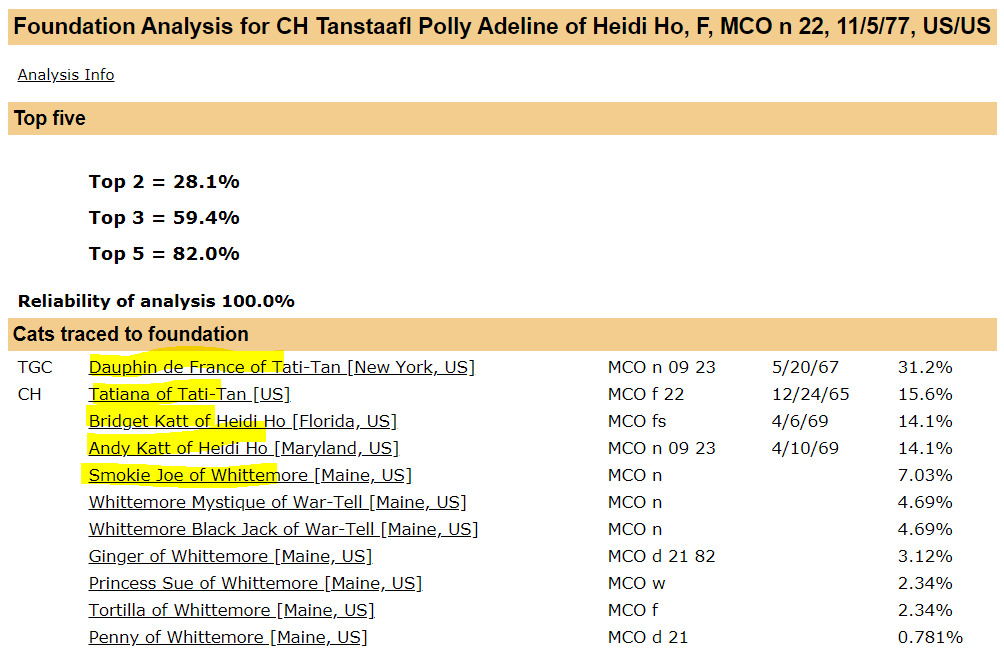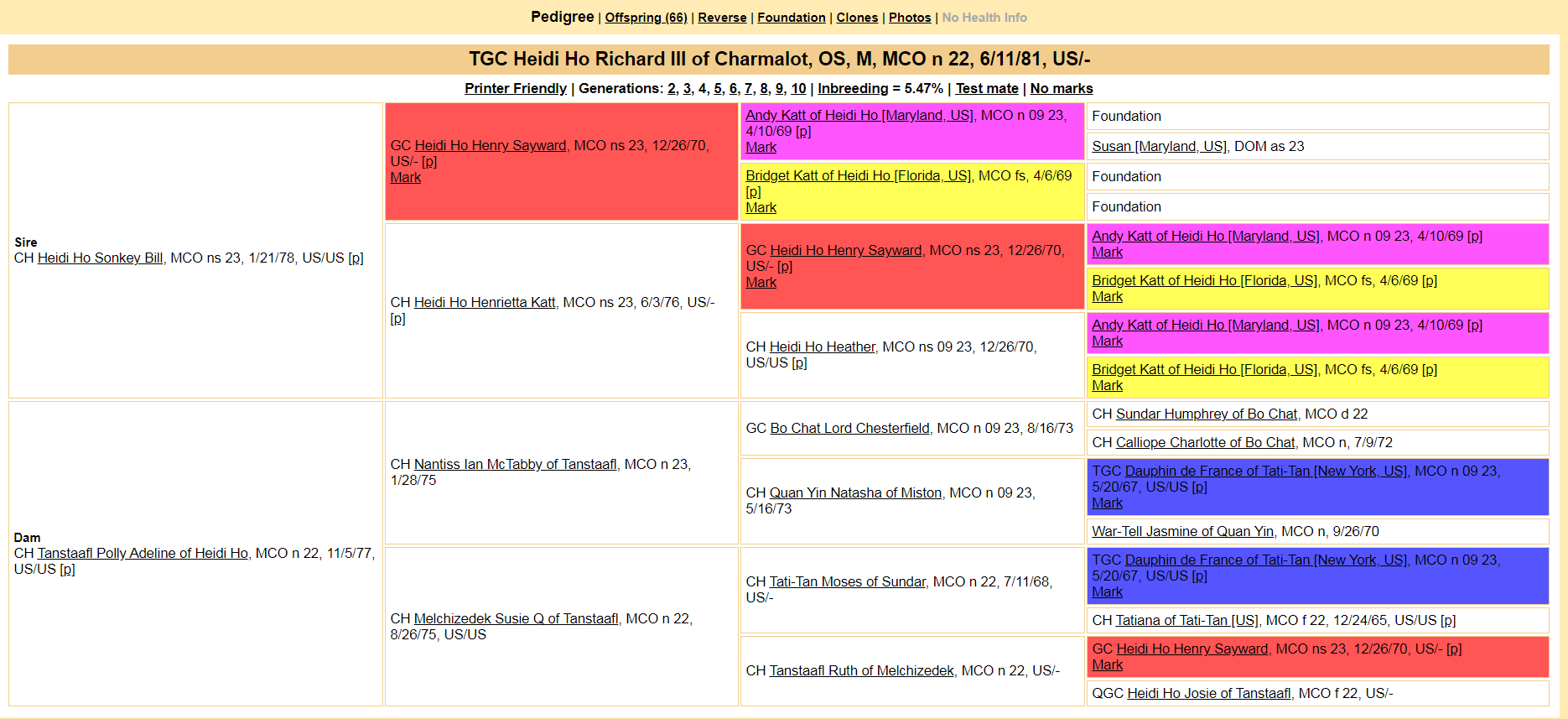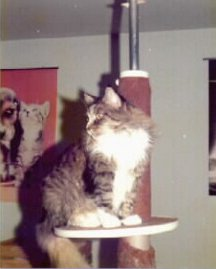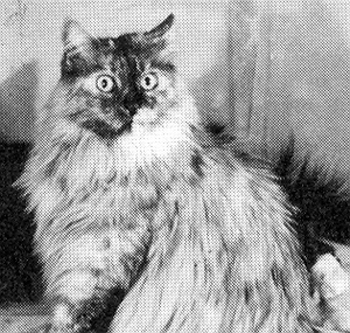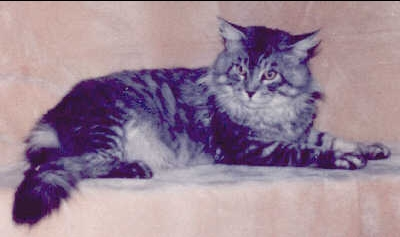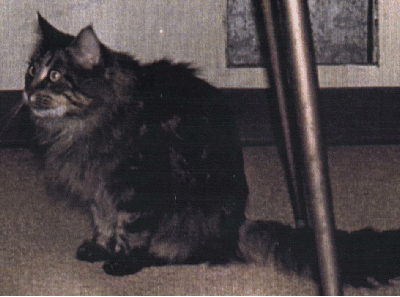- Détails
- Affichages : 1669
Je vais essayer d'expliquer les clones, de manière simple, ce qu'ils sont et comment ils affectent notre élevage. Pour bien comprendre, lisez d'abord la rubrique "Fondation".
En 1978, un chat nommé Heidi Ho Sonkey Bill, est né, il était à la fois fils et double petit-fils d'Andy et Bridget Katt de Heidi Ho. Son père était le fils de ces deux-là et les deux parents de sa mère étaient aussi des descendants de ces deux-là, la consanguinité sur Sonkey Bill en 4 générations était de 37,5%. Ci-dessous est son pedigree avec les marques de couleur pour tous les chats doublés.
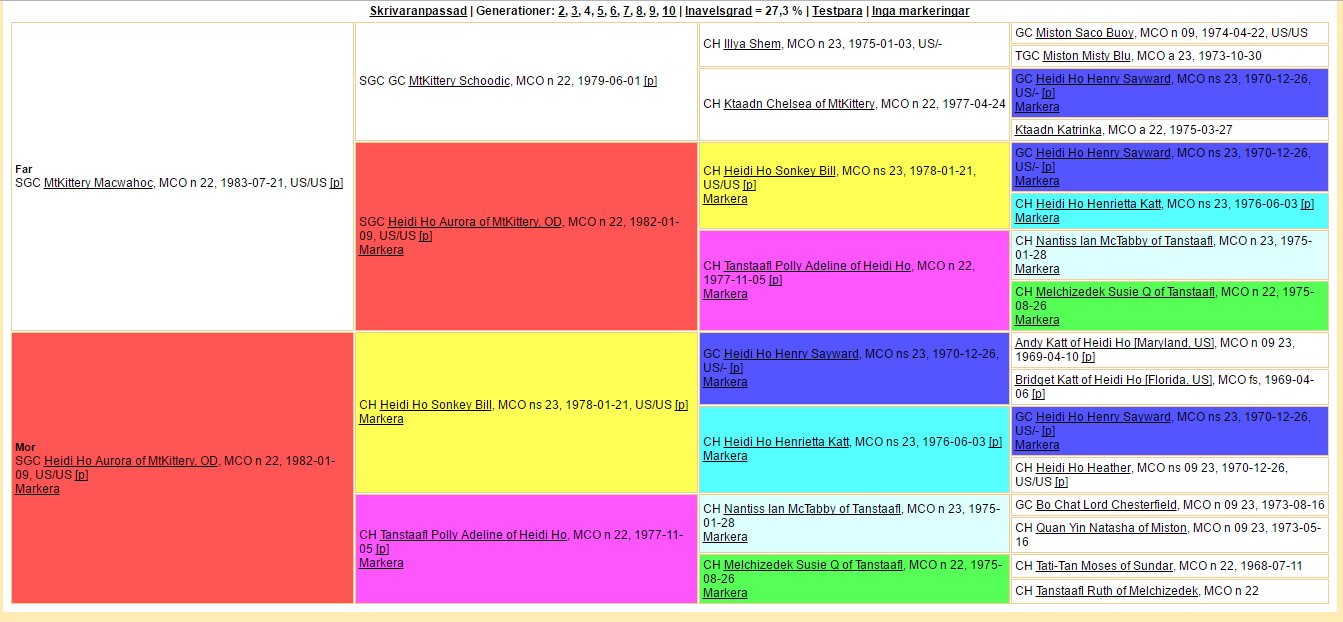
Quand il a été accouplé avec Tanstaafl Polly Adeline, leur progéniture était incroyablement semblable. Ils avaient tous la même apparence, presque comme s'ils avaient été clonés...
Si l'on y réfléchit bien, ce n'est pas si surprenant, leur génétique était très, très serrée. Alors, comment est né le surnom de clones ? Voici l'explication dans les propres mots de Beth Hicks (Tanstaafl) :
Le terme "clone" a été donné aux chats issus de cet élevage en avril 1982. Il y avait une grande exposition de la TlCA à New York. Lynne et moi étions là avec Bunty Washburn, Carol Pedley, Mary Buckmaster, et beaucoup d'autres éleveurs de Maine Coon. Molly Brown (une brown tabby) et Mary's Heidi Ho Lady Arwin (une silver mack tabby) sont toutes deux devenues Supreme Grand Champions à cette exposition. Nous étions tous ensemble dans une chambre d'hôtel ce soir-là quand nous avons appelé Connie pour lui annoncer la nouvelle. Pendant que Connie était au téléphone, quelqu'un a dit : "Dites à Connie que nous savons qu'elle ne fait que cloner ces chats et les peindre de différentes couleurs" !
Voici le lien vers l'interview de Beth Hicks.
Ainsi, lorsque nous parlons des clones aujourd'hui, nous parlons des fils et des filles de Sonkey et Polly. Ci-dessous vous pouvez voir leur pedigree :
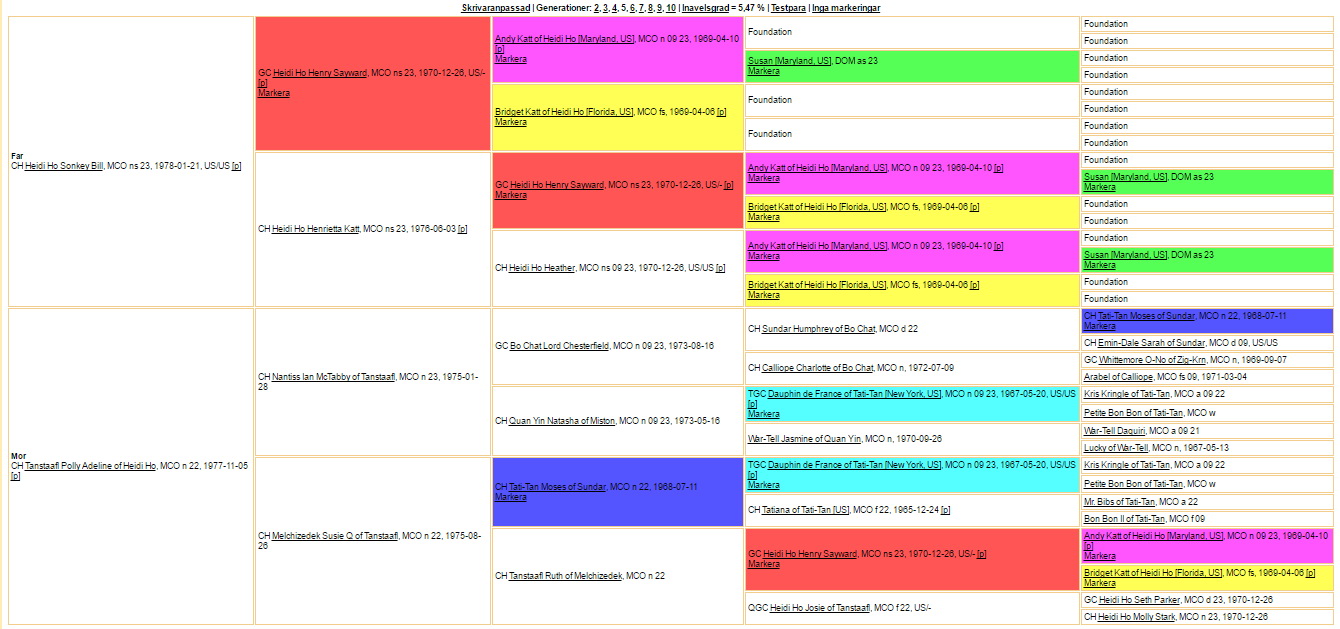
Les clones ont été utilisés à maintes reprises puisque leur progéniture sont devenues des chats de très haute qualité d'exposition et d'une très bonne taille.
De nombreux éleveurs ont décidé qu'un peu était bien, mais que beaucoup était encore mieux !
Même si les clones eux-mêmes n'avaient pas un taux de consanguinité très élevé (9,4%), il y avait beaucoup de croisements en ligne avec eux et leurs descendants.
Aujourd'hui, beaucoup de pedigrees de Maine Coon ont 35% de clones, parfois jusqu'à 50% de clones. Si vous analysez les pedigrees des Maine Coon d'aujourd'hui, vous découvrirez que c'est ce couple *spécial* qui est si commun dans nos pedigrees. Vous découvrirez aussi, si vous commencez à chercher, que trouver un chat "qui n'est pas une nouvelle fondation" qui a moins de 20-25% de clones est impossible, même en cherchant dans le monde entier, c'est un peu effrayant je pense. Il y a environ 10-15 ans, on pouvait encore trouver de rares exemples de chats avec des pedigrees n'ayant presque pas de clones.
Les clones comprennent :
* Heidi Ho Annabel Lee de Tycoon
* Heidi Ho Aurora de MtKittery
* Heidi Ho Barnaby Katt
* Heidi Ho Camille de Calicoon
* Heidi Ho Canth de Tanstaafl
* Heidi Ho Coon Victoria
* Heidi Ho Just Plain Bill Katt
* Heidi Ho Justin Morgan Katt
* Heidi Ho Lady Arwen of Mary B
* Heidi Ho Lovey Mero de Meunerie
* Heidi Ho Molly Brown de Tanstaafl
* Heidi Ho Percival de Meunerie
* Heidi Ho Portius de Olde Farm
* Heidi Ho Rachel Adeline
* Heidi Ho Richard III de Charmalot
* Heidi Ho Sasquatch de Ktaadn
* Heidi Ho Wilyum of Ktaadn
Des informations plus détaillées sur ces chats sont disponibles dans la base de données du Maine Coon.
Il y a également une liste de descendants supplémentaires issus de divers autres accouplements des cinq premiers chats.
Bien, maintenant nous devons essayer de penser en pourcentages.
Si vous imaginez que le pedigree de votre chat est composé de 100 chats = 100%.
Si alors disons que votre chat a 50% de clones dans son pedigree, cela devrait faire 50 chats, non ?
Cela signifie que la moitié de tous les chats du pedigree de votre chat sont issus de la même fratrie !
Si au contraire, disons que votre chat avait 25% de clones, cela signifie que 25 des 100 chats sont des clones.
Dans ce cas, un quart du pedigree de votre chat est constitué de ces 17 frères et sœurs !
Si un nombre doit être mentionné comme une valeur acceptable, il devrait être quelque part autour de 10% de clones, c'est un nombre, même les éleveurs outcross expérimentés ne parviennent pas à garder plus que quelques chats en raison du manque de nouvelles fondations et de chats clonés vraiment faibles.
J'entends souvent des déclarations comme "Oh mon Dieu ! C'était il y a plus de 30 ans !". Cela n'affecte-t-il pas nos chats aujourd'hui ?
Eh bien, c'est exactement ce que cela fait, peu importe comment nous souhaitons "mettre la tête dans le sable" et l'ignorer, nous ne pouvons pas nier qu'il s'agit d'un énorme goulot d'étranglement génétique auquel nous avons affaire sur nos Maine Coons et nous devons travailler avec, nous devons travailler ensemble pour notre race et réduire la valeur des clones en général. Tout le monde n'a pas besoin de travailler avec une nouvelle fondation, mais tout le monde peut suivre les valeurs et les réduire lentement, petit à petit.
J'ai l'habitude de faire une parabole avec une pâte (la pâte = tous les coons du Maine). Nous avons assaisonné la pâte avec un peu de sel (les clones) pour lui donner cette petite touche supplémentaire. Un peu de sel s'est avéré être vraiment savoureux, alors nous avons ajouté un peu plus de sel. Au final, la pâte est devenue assez salée, ce qui signifie 30-35% de sel. On aura beau la bosser et la pétrir, la partager en plusieurs parties et la fusionner à nouveau, elle sera toujours trop salée, non ? Même 30 ans plus tard. Afin de réduire le sel, nous devons ajouter quelque chose d'autre qui ne contient pas de sel, pour la race Maine coon, cela signifie de nouvelles fondations ou des chats qui n'ont aucun lien avec les clones.
Par: Malin Sundqvist
Dagdrivarn (www.dagdrivarn.se)
- Détails
- Affichages : 1327
Within the Maine Coon breed we talk about the clones or the clones percentage. But what is meant by this exactly?
When talking about the clones, we are talking about the 17 descendants of Tanstaafl Polly Adeline or Heidi Ho (Polly) and Heidi Ho Sonkey Bill (Sonkey) born between 1979 and 1982. The reason that they were given the name "clones" is because the kittens looked exactly the same. Just as if they were copies of each other, painted with a different color. These comments were also made when the breeder presented her first litter at a show. Because of this the label "the clones" has remained. Both parents got champion titles added to their names and their first growing kittens did very well on show also. This made the clones in the early 1980's very popular. The similar look of the kittens was very desirable at the time, because the predictability of future good showresults made them very attractive for other breeders. Sonkey and Polly together had 7 litters. From these litters, 17 kittens were used into breedingprograms. Below you can see a screenshot from Pawpeds of the clones. The first colums shows that many of them have indeed obtained their showtitles.
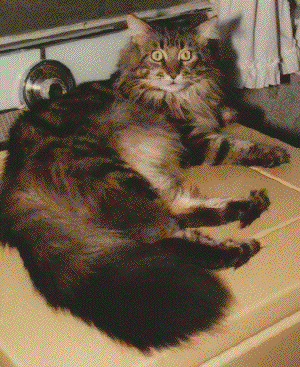
Many of these 17 clone brothers and sisters can still be found in the pedigree of the Maine Coon of today. Nowadays a Maine Coon has a clones percentage of 35% on average. This means that 35% of the pedigree of this cat consists of the clones from 40 years ago. Sometimes the clones can be found more than 70 times in the family tree.
Sonkey - the father of the clones
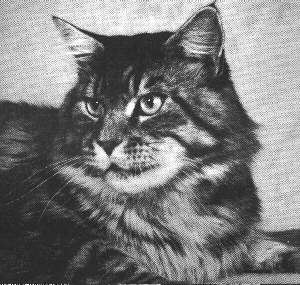
Two children of Andy and Bridget were mated (Henri Sayward and Heather, brother and sister). A daughter of that combination, Henrietta, is again paired with her father (Henri Sayward). Sonkey was born as a result. Sonkey's father is also his grandfather and Sonkey's grandmother is also his aunt. Andy and Bridget are both his grandfather and grandmother on father's side, and twice his great-grandfather and great-grandmother on mother's side. Sonkey therefore has an extremely high total inbreeding coefficient of 37.5%.
Sonkey had 42 offspring (including the 17 clones). Sonkey also became a grandfather of 404 grandchildren, of which 225 related to the clones. The other 179 grandchildren of Sonkey are from female partners other then Polly. Those 179 offspring obviously have a clones percentage of 0%.
In his pedigree you can see the double ancestors in the same color. This is a pedigree that most breeders will avoid at all times. Still, Sonkey and his clones are found in almost all of the Maine Coon family trees today. Can you imagine that when a cat that has 35% in clones, the pedigree consists for 17,5% of father Sonkey, who is the result of a father - daughter mating, where the daughter is the result of a brother - sister mating. It makes you wonder...
Polly - the mother of the clones
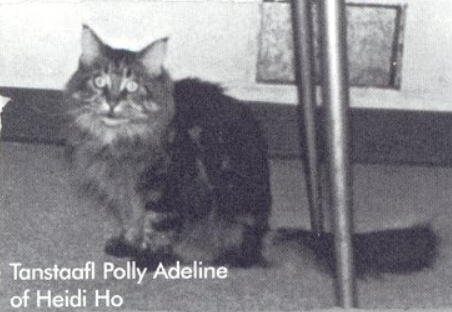
Polly's (Tanstaafl Polly Adeline or Heidi Ho) pedigree consists of fewer inbreeding matings than those of her partner Sonkey. Her total inbreeding percentage is 7.81%. Half of her mother's line consists of Andy and Bridget. But Polly's pedigree also contains the three other foundation cats, which together with Andy and Bridget form the top 5 most common foundation cats. Polly's pedigree consists of Dauphin de France or Tati-Tan for 31.2%.Thanks to Polly, Dauphin is number 3 of the top 5 most common foundation Maine Coons. Followed by Tatiana at number 4 and Smokey Joe at number 5.
The 17 clones
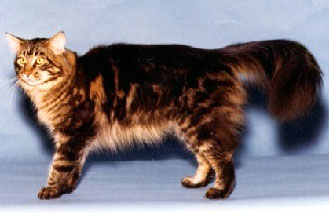 Let's take a closer look at the pedigree of these 17 clones; the kittens of Sonkey and Polly.
Let's take a closer look at the pedigree of these 17 clones; the kittens of Sonkey and Polly.Their inbreeding percentage over 4 generations is 5.47%. And the total inbreeding% is 9.38%. The top 5 foundation cats is 91%. You can see by this high percentage that a high clones percentage automatically means a high top 5 percentage. In fact, this means that the top 5 percentage is AT LEAST 91% of the clones percentage. Example: when a Maine Coon has a clone percentage of 40%, the top 5 percentage has to be at least 36,4%. The other way around you can't predict the height of the clones by looking at the top 5. The top 5 had offspring creating different lines then the clones. In theory a Maine Coon can have a top 5 % of 70% and a clone percentage of 0%. These lines weren't used as much as the lines of the clones and therefor those lines are very rare or maybe even died out.
The most counted ancestors of the clones (also called top 5 foundation):
Number 1 and 2: Bridget Katt of Heidi Ho (Bridget) and Andy Katt of Heidi Ho (Andy) are counted evenly in the pedigree and together are 64,1% of the pedigree of the clones
Number 3: Dauphin de France of Tati-Tan is 15,6% of the pedigree. The total of the top 3 together is 79,7%.
Number 4: Tatiana of Tati-Tan is 7,8% of the pedigree of the clones.
Number 5: Smokie Joe of Whittemore is good for 3,52% of the pedigree of the clones.
The total of this top 5 is 91%.
Now you understand where the top 5 foundation cats came from. The use of the clones in many breedingprograms created this top 5. You will also understand why it is not just a top 5, but the top 3 and top 2 is mentioned separately. There is a big difference between the 32% of Andy and the 3,52% of Smokie Joe.
The impact of the clones today
Because the clones were born about 40 years ago, it is not something that every current breeder takes into account. The clones are mostly no longer visible in the last 10 generations. Many breeders are therefore not aware of their impact today. The volunteers of Pawpeds have therefore developed the possibility to calculate the clones percentage for each Maine Coon. This way you can see exactly what percent of your cat's ancestors consists of the clones. To see this percentage, click on the "clone" link at the top of the family tree in Pawpeds.
The development of the clones
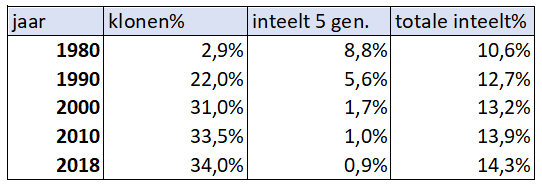
In addition, a Maine Coon with a high clones percentage automatically also has a high foundation top 5 percentage (the 5 most common foundation cats). Only a small percentage of ancestors remains where unrelated ancestors and unrelated genes can come from.
In the 80's there were many other lines that were used for breeding apart from the clones. Unfortunately, the clones were so popular in that period that many breeders sooner or later added an offspring of the clones to his or her own breeding program. Old lines with a low percentage of clones can therefore hardly be found today. The lines that do have a low clones percentage are mainly the lines to which a New Foundation Maine Coon has been added. By adding new blood to the breeding program, the clones percentage can be drastically reduced.
Why low clones is more important than low inbreeding or a low top 5
You may understand that if the current population has an average percentage in clones of 35% or higher, this will result in severe narrowing of the gene pool. The necessity is therefore high to breed with Maine Coons that are as unrelated to these 17 clones as possible.
The clones, top 5 and inbreeding percentages are linked to each other. The higher the clones percentage gets, the higher the Maine Coons parents are related to each other. As explained above, the clones have the top 5 most common ancestors behind. This top 5 will increase together with the increasing clones percentage. The average top 5 foundation percentage is 70% nowadays.
With an increasingly higher clones percentage, the average inbreeding percentage of the population also rises due to their connection to each other. It will then become increasingly difficult for a breeder to make low inbreeding combinations in the future, because there are fewer and fewer unrelated lines to be found. The table shown and discussed above shows this trend well.
The lines that are still low in the clones are often mixed too quickly and too much with lines that are high in the clones. This is often understandable from the point of view of that one breeder. A breeder wants to achieve his own breeding goals and compensate for the weaker points of the line. After all, there is a lot more availability in the population of high clones lines to find the perfect cat to complement your breeding program. However, the total population of the breed would be better served by pairing lines with low clones to other unrelated low clones lines. This increases the amount of cats that are low in the clones. This helps the total population to a higher genetic diversity. In the future this will result in more opportunities of continuing to make low inbreeding combinations. If there are more low clone lines available it will also make it possible for breeders to reach personal breeding goals and work on a higher diversity at the same time.
In summery: low inbreeding is important for short term health, but a low clone percentage helps to keep a high genetic diversity of the breed in the long run.
Low clones - breedingprogram
In the Netherlands there are very few outcross breeders (who breed with a clones percentage below 20%). Of the hundreds (400-500) Maine Coon breeders in the Netherlands, probably around 3-5% focus on outcross. The Netherlands is no exception here, because this trend is visible worldwide.
With this article I hope to create more awareness about the clones among breeders, so that more breeders want to make this a priority in their breeding program. Not everyone can or wants to work with outcross. It can't even be possible for every breeder to work with outcross, because unfortunately there are too few outcross Maine Coons available due to these trends. But every breeder can take the clones into account in his or her breeding program. Even if it is only a few percent per mating or for every new cat that you buy, every small step helps the breed to a lower clones percentage and higher genetic diversity.
By: Debbie Sprenger
You can find more interesting articles about the clones here:
- Interview with the breeder of the clones, Beth Hicks
- Article about the clones and foundation cats and their history
- Détails
- Affichages : 1760
Outcross
Quand on parle de Maine Coon, on parle de clones et de nouvelle fondation/novice, mais aussi d'outcross. Qu'est-ce qu'un outcross ?
Pour être qualifié d'outcross, un chat doit répondre à au moins un des critères suivants :
- 50% ou moins des cinq premiers chats (moyenne 65-70%) ou
- 35% ou moins des trois premiers chats (moyenne 50-55%) ou
- 25% ou moins des deux meilleurs chats (moyenne 35-40%)ou
- 20% ou moins des clones (moyenne 30-35%)
Notez que l'outcross n'est pas la même chose que New foundation ; un chat peut être considéré comme un outcross sans être New foundation.
On appelle aussi souvent ces chats "fondation". En fait, c'est un peu faux puisque c'est de la nouvelle fondation que nous parlons, les chats qui ont initialement posé les bases de la race elle-même sont en fait ceux que l'on appelle la fondation.
Maintenant, lorsque nous apportons du sang neuf à notre race, ceux-ci deviennent de nouvelles fondations. Travailler avec les outcross est incroyablement important pour notre race, mais malheureusement aujourd'hui il y a deux groupes d'éleveurs : ceux qui travaillent uniquement avec les outcross et les nouvelles fondations et s'efforcent d'obtenir des valeurs aussi basses que possible et ceux qui n'y pensent pas du tout, travaillant avec des lignées d'exposition et ne sachant peut-être même pas ce que cela signifie. A l'origine, cependant, une nouvelle fondation a été mise en place pour élever nos chats hautement clonés et faire baisser leurs valeurs. Cela semble avoir été oublié par certains éleveurs aujourd'hui.
Quand il s'agit de mon propre élevage, je varie beaucoup, je l'ai toujours fait, j'ai souvent eu un peu plus haut (mais pas des valeurs trop élevées à cause des risques qu'elles comportent) mais quelque chose de plus haut avec un peu plus bas. J'ai souvent prêté les étalons inférieurs que j'avais. Pour aider à réduire les clones chez les femelles possédées par ceux qui montrent qu'ils sont vraiment intéressés à réduire la valeur de leurs chats, et pas seulement pour pouvoir emprunter un beau mâle outcross.
We should all work together here, everyone should work with outcross in some degree, it does not mean everyone has to work with a New foundation and really low values in clones, but we should definitely work together to bring down the values within a few years, so no Maine Coon has such sky-high values as they have today. Where the limit goes for what makes sense is terribly hard to say, but when they fall over 35% in clones, it's definitely too high and the inbreeding depression, might be just around the corner, lurking like a timed bomb. No one can tell if this will go off today or in 10 years, but it will go off sooner or later.
Dans un monde ultime, aucun Maine Coon ne dépasserait 20-25% de clones et la valeur normale serait d'environ 10%, mais nous sommes loin, très loin, de ce point aujourd'hui.
Par: Malin Sundqvist
Dagdrivarn (www.dagdrivarn.se)
- Détails
- Affichages : 1130
There are many many pages and history of the breeds early history, most articles are talking only about the old history of how the breed came to exist and how it got its name. In this article, I will talk a bit more about the foundation of our breed and when and how the clones came into existence.
Today we often talk about foundation, but with this, we then actually mean new foundation!
But we often forget that foundation is the main foundation of our breed, Maine Coon is a natural breed, they are from Maine, USA. Where they for centuries kept farms free from rats and mice and just like our domestic cat/farm cat, the one that is also registered as European Shorthair so was it even with Maine Coon in the beginning. The Maine Coon is still today a domestic cat/farm cat USA.
Just as we a couple of years ago still could get the moggies from Sweden recognized as a European Shorthair, it’s still possible to find a cat who got all the characteristics of a Maine Coon and get that one registered as a Maine coon in the USA. Of course, if they do not have a pedigree they are just domestic cats as same as for all not registered cats, but we do have the possibility to register cats as a new foundation to get new blood into our breed.
But I will not go further in on that subject, on PawPeds there is a list over the early foundation cats, and also some new foundation with later dates is on that list, but most of them are the early first foundation.
FoundationCatList
I have also got the understanding that many breeders in Sweden today and possibly rest of Europe, do not know that much about the clones, and not really understand their impact on our breed. Many talks about the clones (now remember they were nothing more then 17 siblings), as if they were the founders of our breed, which is far from correct.
They were just a piece of a big cake with many, many different pieces and the clones themselves when they where born, was just a little piece of this giant cake of different lines. I also heard it said: Behind the more “extreme” cats is the cats from Heidi Ho’s lines, clones (offsprings of Heidi Ho Sonkey Bill and Tanstaafl Polly Adeline of Heidi Ho).
As if those cats would have some impact of that extreme type that many MCO got today.
The thing is that those more extreme type cat, that so many today suggests is the “correct” type, is far, far from the type that the clones actually had. So to have high values of the clones does not have anything to do with the type, this is nothing more than a huge bottleneck which has reduced the genetic variation in those cats a lot.
To understand more about the impact they had on the breed and understand more about who they really were, we have to go back a good part in time. Back to the time before the clones were born. It seems like many have not understood that the clones, in fact, were what we today call F4. Foundation in 4:th generation. I will put a link to their pedigree further down the document. But first… how it all began!
1969 Connie Condit (Heidi Ho) thought in a army nursing school. At the student home was a pregnant homeless little brown mackerel tabby female moving around, they gave her the name Susan.
This little female did not qualified to be a Maine Coon, she looked according to Connie Condit, like the Kliban-sneaker cat but without shoes… this female got to move in with Connie.
Picture below of the Kliban-Sneaker-cat.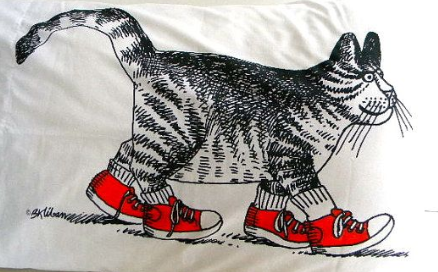
Just two weeks after Susan had moved in with Connie she gave birth to for big strong boys, two black, one brown mackerel tabby and one brown classic tabby white. Susan was neutered and got to move to Connie's mother. The Brown classic tabby white boy was named Andy (Andy Kat of Heidi Ho), and got to stay with Connie.
When he was 6 months old Connie met Bonnie Rich (Richelieu), who went bonkers over Andy and insisted that Connie must register him, show him and breed him. Connie did thought she was nuts, considering his mother and unknown father, but Bonnie explained the process of foundation-registration to Connie and just to get her to shut up, Connie did write to ACA and got him registered.
After a vacation in Florida, Bonnie had a date with her to Andy, a female named Bridget (Bridget Katt of Heidi Ho). Connie still had no intentions getting into breeding, but did join MCBFA (Maine Coon Breeders and Fanciers Association) to learn a bit more about Maine Coon. There she got in contact with Betty Ljostad who suggested that she would take Andy to a show, to let the judges decide whether he was a Maine Coon. He came home a Champion. Bridget was then already pregnant.
I this first litter Connie kept three females:
Heidi Ho Heather, Heidi Ho Molly Stark and Heidi Ho Fanny Abigail
She also kept two males:
Heidi Ho Seth Parker and Heidi Ho Henry Sayward
This was made to inbreed them and sort out possible bad genes, here we have to consider, that at this time the thought was different about inbreeding, this was thought to be the best way to clean out bad genes, that in this way you forced the bad recessives genes out into the light. Well, today we do know better, but at this time this was how it was done. One of the more famous breedings she did was the one with Henrietta who was the daughter of Heidi Ho Heather and Heidi Ho Henry Sayward, where she mate her to her father, in this litter was Heidi Ho Sonkey Bill born, who is the father of the clones.
After Connie got Heidi Ho Sonkey Bill after Henrietta and Henry, she neutered all the 5 earlier cats Henry, Seth, Fanny Abigail, Molly Stark, and Heather.
She had then already bought in two new, Tanstaafl Polly Adelaine and also Ktaadin Oquossoc.
To do some line breeding and here the story we all so well know begins. The one about the clones.
Connie realized that this mating between Henrietta och Henry, was a risk, but a risk she was willing to take. She had been living in German for a long time and did not know any breeders with males she could think of using, Henrietta was already 2 years old and in need of being mated. She had also kept Becky (Heidi Ho Rebecca Katt) a female from Seth Parker and Polly Adelaine to continue Seth's genes.
As you can see above it was a lot of inbreeding and as said before, this was something you did at this time, believing that you this way sorted out bad recessive genes.
Andys nose break was a bit too much, Connie corrected this by mating him to Bridget.
After this, she mated him to Polly Adeline and the rest is history.
The first litter was born 1979-01-20, I do not know if only one was born in this litter or if this is the only one did end up in PawPeds, but in this litter was:
Heidi Ho Barnaby Katt.
1979-07-01 a new litter arrived between those two also in this is just one registered in PawPeds who went into breeding:
Heidi Ho Percival of Meunderie.
1979-10-19 next litter came in this there were two offsprings who got into breeding:
Heidi Ho Molly B. of Tanstaafl and Heidi Ho Wilyum of Ktaadn.
1980-08-11 one more litter arrived 4 went into breeding:
Heidi Ho Canth of Tanstaafl, Heidi Ho Coon Victoria, Heidi Ho Portius of Olde Farm
1981-06-11 next litter arrived also here there were four kittens into breeding:
Heidi Ho Lady Arwen of Mary B, Heidi Ho Lovey Mero of Meunerie, Heidi Ho Richard III of Carmalot and Heidi Ho Sasquatch of Ktaadn.
1982-01-09 second last litter four into breeding in this too:
Heidi Ho Annabel Lee of Tycoon, Heidi Ho Aurora of MtKittery, Heidi Ho Camille of Calicoon and Heidi Ho Justin Morgan Katt.
1982-11-02 the last litter was born, from this 2 more went into breeding:
Heidi Ho Just Plain Bill Katt and Heidi Ho Rachel Adeline.
These 17 siblings we call the clones became extremely popular and was used to much a lot too much.
They became what we today call marathon-males and marathon-females (maybe this is a Swedish expression for overused males and females?) and you continued to inbreed even more to make them even stronger genetically.
Why they are called the clones is in another shorter article called About the Clones.
Some thoughtful words from Connie herself are:
I've never understood why people say they like a certain breed and then set out to change the first one thing, then another. Years ago, a beginning breeder wrote to me for advice on her breeding program. She asked, "What do the judges like?" My reply was very blunt: to H*** with what the judges like; breed to the standard! When I first started, very few judges knew a good Maine Coon when they fell over one!"
Other thoughtful words from Connie today when we do have so many cats with so high percentage on the clones in their pedigrees (often 35-45%) is:
The people who bred with clones would have done better to breed with good Maine Coon-type foundation cats to widen the gene pool.
I was not totally pleased with the way the clones matured; they were too lean and lanky and at least part of them was too fine-boned. They should have been bred to more outcrossed lines.
and also
Right now, there is too much Heidi Ho in most lines; we need new blood transfusions.
Above is so the history of the becoming of the clones and the background to them, where they came from and the fact, they actually were foundation cats. Something you might take into consideration, before you give in to the urge to speak derogatory, about those who are today working with foundation cats, and outcross. You should also consider Connie's own words, maybe also respect her wish. Without Connie those cats would have never existed, so by working with outcross myself, I feel that I honor her by fulfilling her wish by working with outcross and mix in some new blood in my breeding.
If you create an account on Pawpeds you can choose to mark double, which is a big help if you want to see more clearly what inbreeding there is in a pedigree behind the clones and also after the clones.
Here is one of the clones pedigree in 6 generations. If you do seek and count the number of hits if you search for Andy Katt and Bridget Katt in 6 generations you can see that you get 7 hits on Andy and 6 hits on Bridget. If you would stumble on a cat with this composition today would you for a second consider using this cat in your breeding? I guess most of you would not.
Heidi Ho Aurora
Most of you would really not do this, despite this so many continue to use very high cloned cats in their breeding, without really knowing what this actually means for the breed.
Today the clones are unfourtnantly so far back in the pedigrees that it’s hard for people to visually see them and see the actual impact of them, all we can see is a percentage, who most of us have trouble really understand the impact of. In most of the cats today the clones are further back then 10 generations and we can thereby not physically actually see them in our pedigrees, this makes them a bit unreal.
I fully understand that it’s hard to really understand the impact of those cats so far back in our pedigrees, but if we consider that nothing has changed, just because they are moved further back, it’s still the same amount of cats there, we just can’t see them anymore.
Let's use one of my old boys as an example, he was born in 2006 and did not had those sky-high percentage on the clones that many have today he was about 35%, but in his pedigree, you can actually do an experiment to see a bit more clearly how it actually is behind the cats who got higher values on the clones.
Click on the link, Google Chrom is to prefer, press CTRL-F to get the search box to appear up in the right corner. Then search for Heidi Ho Aurora (who was one of the clones), consider this is just ONE of them and there are actually 17 of them. If you want to experiment do a search for the other 17 also.
But searching for Heidi Ho Aurora on my Lilleman will show that in 10 generations, she appears 86 times!
Lilleman
As a closure, since I have been talking a whole lot of the clones, about their history and how they got to be so popular and common, do not forget that those cats were not the founders of the breed!
They were just a small, small part of all the many, many, many other cats that actually where the foundation of our breed.
When we do look at the top 5, we do see the five most common foundation cats, is actually behind the clones to a big part, but if we then do look at the foundation list, which I linked to in top of this article, we can see that there is a LOT more foundation cats then those five. Those are the foundation of our breed, not the clones themselves even if they in the early 80 did get overused and did take over the breed almost completely.
Below are some pictures of the cats I have been talking about above, they are all published in PawPeds in the pedigree and also on MCHS. Click on the pictures to get to the source of the picture and also to see more pictures in some cases.
|
Andy Katt of Heidi Ho |
Bridget Katt of Heidi Ho |
|
Heidi Ho Henry Sayward |
Heidi Ho Heather |
|
Tanstaafl Polly Adeline of Heidi Ho |
By: Malin Sundqvist
Dagdrivarn (www.dagdrivarn.se)
- Détails
- Affichages : 1891
Expliquer le concept de fondation n'est pas toujours simple, mais je vais faire un effort ici pour l'expliquer le plus facilement possible.
En commençant par une parabole sur la façon dont une race de chat peut commencer, nous utilisons une race fictive.
Nous avons un type de chat sauvage dans le pays qui a une apparence spéciale, disons que tout les chats ont le motif zébré. Maintenant, quand nous allons commencer la race, nous devons sortir et trouver des chats qui ressemblent à cela et qui ont aussi un "type", c'est-à-dire une apparence qui correspond à la nouvelle "race" que nous avons imaginée. Nous avons décidé d'appeler notre nouvelle race Zebris. Nous allons sortir dans le village et chercher de très beaux spécimens, et ceux que nous avons décidé, correspondent bien à notre "standard" en ce qui concerne le type et le patron. Nous enregistrerons ces chats sous le nom de Zebris. Ces premiers chats de la race Zebris deviennent alors les fondateurs de la race, c'est-à-dire la Fondation.
50 ans plus tard, nous réalisons que nous devons élargir un peu notre base d'élevage. Nous devons alors retourner en arrière pour voir si nous pouvons trouver de beaux spécimens sauvages qui correspondent et que nous pouvons enregistrer comme "nouveaux fondateurs" de la race. Nous pouvons même avoir la chance de voir qu'il existe une race similaire à la nôtre, cette race s'appelle Zabris. Nous pouvons alors les élever avec nos Zabris et les incorporer comme "nouvelle fondation" dans notre race.
Lorsque nous parlons de Maine Coon, le classement en grade 2, 3 et 5 concerne nos chats de fondation d'origine les plus courants (2, 3 et 5).
Voici les premiers chats qui ont été enregistrés comme Maine Coon. La liste complète des chats de la fondation se trouve ici !
Les chats qui comptent pour le Top5 sont :
* Andy Katt de Heidi Ho
* Bridget Katt de Heidi Ho
* Dauphin de France de Tati-Tan
* Tatiana de Tati-Tan
* Whittemore Smokie Joe (ou Smokie Joe of Whittemore)
Dans le cas du Top3, il s'agit de la présence des trois premiers chats sur le Top 5.
Andy Cat of Heidi Ho, Bridget Cat of Heidi Ho et Dauphin de France of Tati-Tan.
Par conséquent, le Top2 concerne la présence des deux tops dans le pedigree.
Ie Andy Cat et Bridget Cat de Heidi Ho.
Les novices sont en fait les mêmes que les nouvelles fondations.
Mais notez que lorsque nous parlons de fondation et d'outcross, ce n'est pas forcément la même chose !
Voici plus à lire sur le travail avec la fondation pour ceux qui sont intéressés.
Auteur: Malin Sundqvist


